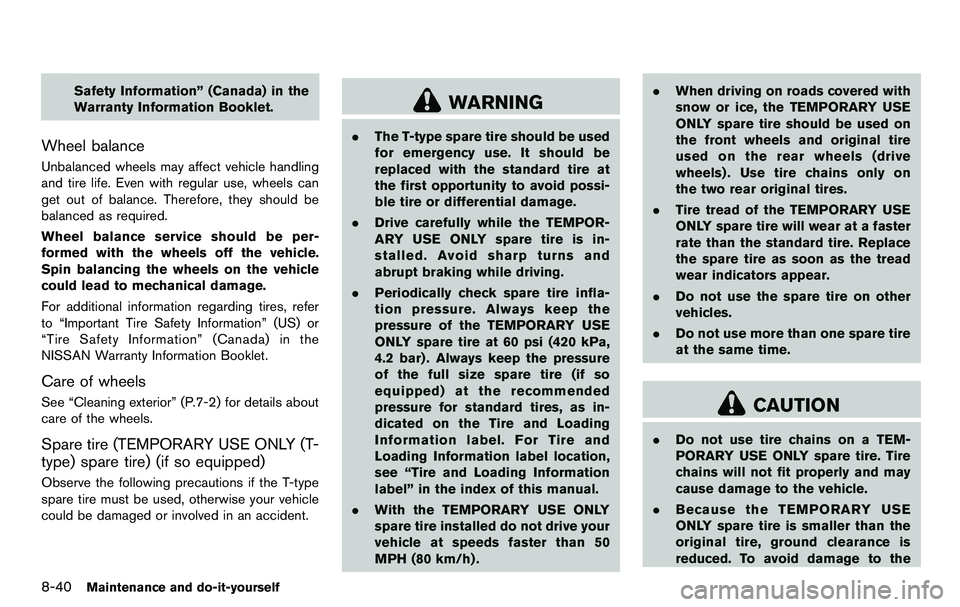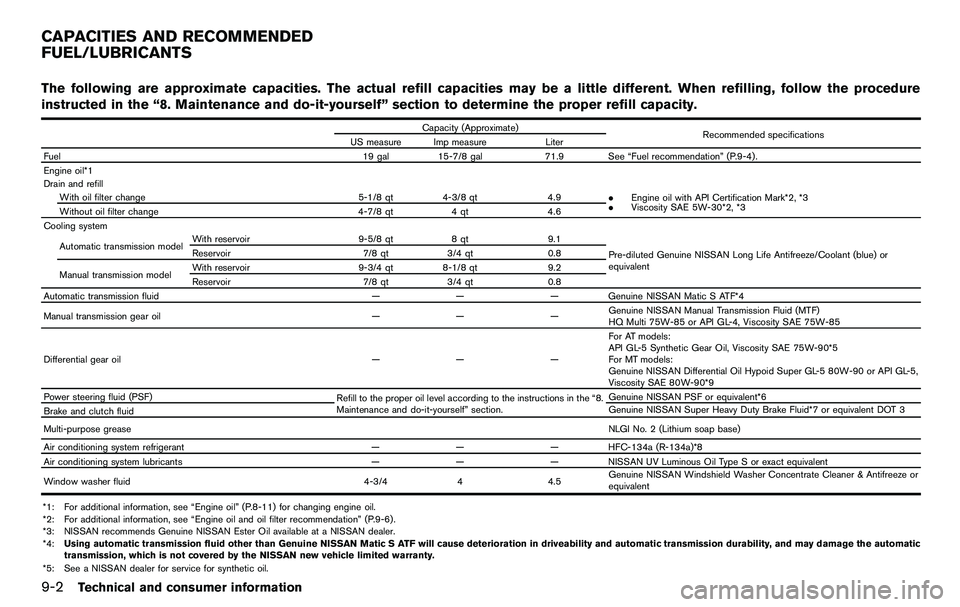Page 323 of 427
on other vehicles. The jack is de-
signed for lifting only your vehicle
during a tire change.
. Use the correct jack-up points.
Never use any other part of the
vehicle for jack support.
. Never jack up the vehicle more than
necessary.
. Never use blocks on or under the
jack.
. Do not start or run the engine while
vehicle is on the jack, as it may
cause the vehicle to move. This is
especially true for vehicles with
limited slip differentials.
. Do not allow passengers to stay in
the vehicle while it is on the jack.
Carefully read the caution label attached
to the jack body and the following instruc-
tions.
SCE0790
Jack-up point
1. Place the jack directly under the jack-up point as illustrated so the top of the jack
contacts the vehicle at the jack-up point.
Align the jack head between the two
notches in the front or the rear as shown.
Also fit the groove of the jack head between
the notches as shown.
The jack should be used on level firm
ground.
In case of emergency6-5
Page 392 of 427

8-40Maintenance and do-it-yourself
Safety Information” (Canada) in the
Warranty Information Booklet.
Wheel balance
Unbalanced wheels may affect vehicle handling
and tire life. Even with regular use, wheels can
get out of balance. Therefore, they should be
balanced as required.
Wheel balance service should be per-
formed with the wheels off the vehicle.
Spin balancing the wheels on the vehicle
could lead to mechanical damage.
For additional information regarding tires, refer
to “Important Tire Safety Information” (US) or
“Tire Safety Information” (Canada) in the
NISSAN Warranty Information Booklet.
Care of wheels
See “Cleaning exterior” (P.7-2) for details about
care of the wheels.
Spare tire (TEMPORARY USE ONLY (T-
type) spare tire) (if so equipped)
Observe the following precautions if the T-type
spare tire must be used, otherwise your vehicle
could be damaged or involved in an accident.
WARNING
.The T-type spare tire should be used
for emergency use. It should be
replaced with the standard tire at
the first opportunity to avoid possi-
ble tire or differential damage.
. Drive carefully while the TEMPOR-
ARY USE ONLY spare tire is in-
stalled. Avoid sharp turns and
abrupt braking while driving.
. Periodically check spare tire infla-
tion pressure. Always keep the
pressure of the TEMPORARY USE
ONLY spare tire at 60 psi (420 kPa,
4.2 bar) . Always keep the pressure
of the full size spare tire (if so
equipped) at the recommended
pressure for standard tires, as in-
dicated on the Tire and Loading
Information label. For Tire and
Loading Information label location,
see “Tire and Loading Information
label” in the index of this manual.
. With the TEMPORARY USE ONLY
spare tire installed do not drive your
vehicle at speeds faster than 50
MPH (80 km/h) . .
When driving on roads covered with
snow or ice, the TEMPORARY USE
ONLY spare tire should be used on
the front wheels and original tire
used on the rear wheels (drive
wheels) . Use tire chains only on
the two rear original tires.
. Tire tread of the TEMPORARY USE
ONLY spare tire will wear at a faster
rate than the standard tire. Replace
the spare tire as soon as the tread
wear indicators appear.
. Do not use the spare tire on other
vehicles.
. Do not use more than one spare tire
at the same time.
CAUTION
.Do not use tire chains on a TEM-
PORARY USE ONLY spare tire. Tire
chains will not fit properly and may
cause damage to the vehicle.
. Because the TEMPORARY USE
ONLY spare tire is smaller than the
original tire, ground clearance is
reduced. To avoid damage to the
Page 396 of 427

9-2Technical and consumer information
The following are approximate capacities. The actual refill capacities may be a little different. When refilling, follow the procedure
instructed in the “8. Maintenance and do-it-yourself” section to determine the proper refill capacity.
Capacity (Approximate)Recommended specifications
US measure Imp measure Liter
Fuel 19 gal 15-7/8 gal 71.9 See “Fuel recommendation” (P.9-4).
Engine oil*1
Drain and refill With oil filter change 5-1/8 qt 4-3/8 qt 4.9 .Engine oil with API Certification Mark*2, *3
. Viscosity SAE 5W-30*2, *3
Without oil filter change 4-7/8 qt 4 qt 4.6
Cooling system
Automatic transmission model With reservoir
9-5/8 qt8 qt 9.1
Pre-diluted Genuine NISSAN Long Life Antifreeze/Coolant (blue) or
equivalent
Reservoir
7/8 qt3/4 qt 0.8
Manual transmission model With reservoir
9-3/4 qt8-1/8 qt 9.2
Reservoir 7/8 qt3/4 qt 0.8
Automatic transmission fluid —— —Genuine NISSAN Matic S ATF*4
Manual transmission gear oil —— —Genuine NISSAN Manual Transmission Fluid (MTF)
HQ Multi 75W-85 or API GL-4, Viscosity SAE 75W-85
Differential gear oil —— —For AT models:
API GL-5 Synthetic Gear Oil, Viscosity SAE 75W-90*5
For MT models:
Genuine NISSAN Differential Oil Hypoid Super GL-5 80W-90 or API GL-5,
Viscosity SAE 80W-90*9
Power steering fluid (PSF) Refill to the proper oil level according to the instructions in the “8.
Maintenance and do-it-yourself” section.Genuine NISSAN PSF or equivalent*6
Brake and clutch fluid Genuine NISSAN Super Heavy Duty Brake Fluid*7 or equivalent DOT 3
Multi-purpose grease NLGI No. 2 (Lithium soap base)
Air conditioning system refrigerant —— —HFC-134a (R-134a)*8
Air conditioning system lubricants —— —NISSAN UV Luminous Oil Type S or exact equivalent
Window washer fluid 4-3/444.5Genuine NISSAN Windshield Washer Concentrate Cleaner & Antifreeze or
equivalent
*1: For additional information, see “Engine oil” (P.8-11) for changing engine oil.
*2: For additional information, see “Engine oil and oil filter recommendation” (P.9-6).
*3: NISSAN recommends Genuine NISSAN Ester Oil available at a NISSAN dealer.
*4: Using automatic transmission fluid other than Genuine NISSAN Matic S ATF will cause deterioration in driveability and automatic transmission durability, and may damage the automatic
transmission, which is not covered by the NISSAN new vehicle limited warranty.
*5: See a NISSAN dealer for service for synthetic oil.
CAPACITIES AND RECOMMENDED
FUEL/LUBRICANTS